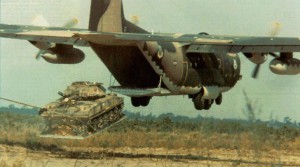
The stories are getting simple enough and ridiculous enough for the average American to start getting it.
The Disturbing History of One of the Pentagon's Most Expensive Flying Turkeys
EXTRACT
The C-130 Hercules, or Herk for short, isn't a sexy plane. It hasn't inspired hit Hollywood films, though it has prompted a few photo books, a beer, and a “Robby the C-130” trilogy for children whose military parents are deployed. It has a fat sausage fuselage, that snub nose, overhead wings with two propellers each, and a big back gate that comes down to load and unload up to 21 tons of cargo.
The Herk can land on short runways, even ones made of dirt or grass; it can airdrop parachutists or cargo; it can carry four drones under its wings; it can refuel aircraft; it can fight forest fires; it can morph into a frightening gunship. It's big and strong and can do at least 12 types of labor — hence, Hercules.
Too Much of a Good Thing
Here's where the story starts to get interesting. After 25 years, the Pentagon decided that it was well stocked with C-130s, so President Jimmy Carter’s administration stopped asking Congress for more of them.

Lockheed was in trouble. A few years earlier, the Air Force had started looking into replacing the Hercules with a new medium-sized transport plane that could handle really short runways, and Lockheed wasn't selected as one of the finalists. Facing bankruptcy due to cost overruns and cancellations of programs, the company squeezed Uncle Sam for a bailout of around $1 billion in loan guarantees and other relief (which was unusual back then, as William Hartung points out his magisterial Prophets of War: Lockheed Martin and the Making of the Military-Industrial Complex).
Then a scandal exploded when it was revealed that Lockheed had proceeded to spend some $22 million of those funds in bribes to foreign officials to persuade them to buy its aircraft. This helped prompt Congress to pass the Foreign Corrupt Practices Act.
So what did Lockheed do about the fate of the C-130? It bypassed the Pentagon and went straight to Congress. Using a procedure known as a congressional “add-on” — that is, an earmark — Lockheed was able to sell the military another fleet of C-130s that it didn’t want.
To be fair, the Air Force did request some C-130s. Thanks to Senator John McCain, the Government Accountability Office (GAO) did a study of how many more C-130s the Air Force requested between 1978 and 1998. The answer: Five.
How many did Congress add on? Two hundred and fifty-six.
As Hartung commented, this must “surely [be] a record in pork-barrel politics.”
Phi Beta Iota: We love the C-130. Within a coherent strategy, the C-130 is very well qualified to be the standard short-haul transport. The problem is with long-haul transport, close air support, and mutli-functional vertical lift. DoD has been unpressional, short-sighted, and at the service and OSD levels, abjectly corrupt in not fully integrating requirements for a distributed 450-ship Navy, a long-haul Air Force capable of moving a division a week with organic, and doing a Berlin Airlift with conscripted, and an air-liftable Army. The USA does not lack ofr money or imagination, only for intelligence with integrity. The above article is a good example of lobbying run amok, but it is unfortunately also tarnishing an excellent aviation platform.
See Also:
Chuck Spinney: Buy Before You Fly … How to Suck Money During Sequestration […Legalized Treason?]
Chuck Spinney: Treason Thy Name is F-35A aka “Acquisition Malpractice”
Winslow Wheeler: DoD’s Own F-35 Test Report Contains Useful Truths
Winslow Wheeler: Treason Thy Name is F-35A — We Expect Hagel to “Do A Cheney”



